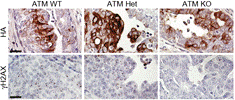Veterinary and Biomedical Sciences, Department of
Date of this Version
2015
Document Type
Article
Citation
Published in final edited form as: Scandinavian Journal of Immunology 2015 November ; 82(5): 399–408. doi:10.1111/sji.12344.
PMCID: PMC4610346 ;NIHMSID: NIHMS726723 ; PMCID:PMC4610346 http://www.ncbi.nlm.nih.gov/pubmed/26207337
Abstract
The advent of major histocompatibility complex (MHC) tetramer technology has been a major contribution to T cell immunology, because tetramer reagents permit detection of antigen-specific T cells at the single-cell level in heterogeneous populations by flow cytometry. However, unlike MHC class I tetramers, the utility of MHC class II tetramers has been less frequently reported. MHC class II tetramers can be used successfully to enumerate the frequencies of antigen-specific CD4 T cells in cells activated in vitro, but their use for ex vivo analyses continues to be a problem, due in part to their activation dependency for binding with T cells. To circumvent this problem, we recently reported the creation of a new generation of reagents called MHC class II dextramers, which were found to be superior to their counterparts. In this review, we discuss the utility of class II dextramers vis-a-vis tetramers, with respect to their specificity and sensitivity, including potential applications and limitations.


Comments
Copyright 2015 The Foundation for the Scandinavian Journal of Immunology; published by John Wiley & Sons. PubMed Central version used by permission.